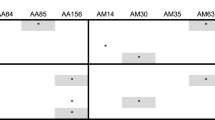Summary
4.1 The cross-pollination of clones ofLolium perenne was studied in unreplicated clonal plantations and in polycross fields with the aid of a simple dominant character, roughness of culms and upper leaf sheaths. Heterozygous rough clones were used as sources of contaminating pollen and homozygous recessive smooth clones as testers.
4.2 In the clonal fields the cross pollination rapidly decreased over the first 3 to 4 rows and after that only slowly. Simultaneousness of flowering often had a greater effect on the percentage of crossing than vicinity. In spite of differences in flowering time of one week the clones were fertilized on an average for 40% by the two adjacent clones and for 74% by the three neighbours on both sides.
4.3 It was demonstrated that in unreplicated clonal fields the various clones are pollinated by genotypically different pollen mixtures, whereas in polycross fields a genotypical homogeneous pollination may be obtained. Polycrossed progenies, therefore, make possible a much more reliable testing of the genotype of the clones than open pollinated progenies.
4.4 In two polycross fields differences in flowering time of more than one week and differences in pollen production disturbed seriously the homogeneousness of the pollination. There is need for more experimental evidence upon which the proper design of a polycross field may be based.
Samenvatting
De bestuiving van Engels raaigras in klonenvelden en massale proefkruisingen
1. In klonenvelden van Engels raaigras werden onder 118 klonen 10 aangetroffen, waarvan de halmen en bovenste bladscheden door het voorkomen van kleine tandjes ruw aanvoelden. De ruwe klonen bleken alle heterozygoot, de gladde homozygoot recessief te zijn.
2. De ruwe klonen gaven na vrije bestuiving in de klonenvelden ongeveer 50 % ruwe zaailingen; vrijwel al het zaad ontstond dus na kruisbevruchting.
3. Uit het percentage ruwe planten in zaaisels van gladde klonen bleek, dat in de klonenvelden de onderlinge kruising van de eerste tot de derde rij zeer snel en daarna steeds langzamer afnam. Gemiddeld werd elke kloon voor 40 % door de beide aangrenzende klonen bestoven en voor resp. 22, 12, 11, 7, 5 en 4 % door de verdere opeenvolgende paren van klonen. Bij gelijktijdige bloei zou de kruising nog meer tot de aangrenzende klonen zijn beperkt.
4. Terwijl in de klonenvelden de klonen door verschillende stuifmeelmengsels werden bestoven, werd in enkele massale proefkruisingen een genotypisch uniforme bestuiving verkregen. De generatieve toetsing zal daarom bij massale proefkruising veel betrouwbaarder zijn dan bij gebruik van vrij bestoven klonenzaad.
5. Verschillen in bloeitijd van meer dan een week en verschillen in stuifmeel productie tussen de klonen bleken de gelijkmatigheid van de bestuiving in de massale proefkruisingen ernstig te verstoren.
Similar content being viewed by others
Literature
Frandsen, H. N., Some breeding experiments with timothy. Imp. Agr. Bur. joint publ.3 (1940): 80–92.
Frandsen, H. N. andK. J., Polycross-metoden. Nordisk Jordbruksforskning7–8 (1948): 239–261.
Griffiths, D. J., The liability of seed crops of perennial ryegrass, (Lolium perenne) to contamination by windborne pollen. Agr. Sc.40 (1950): 19–38.
Jenkin, T. J., Perennial rye-grass at Aberystwyth. The Welsh Journ. of Agr.6 (1930): 140–165.
Tysdal, H. M., Kiesselbach, T. A. andWestover, H. L., Alfalfa breeding. Nebraska Agr. Exp. Stat. res. bull.124 (1942): 1–46.
Wellensiek, S. J., Rational methods for breeding cross-fertilizers. Meded. Landbouwhogeschool48 (1947): 227–262.
, The principle of mass test-crosses in breeding cross-fertilizers. Proc. VIII Int. Congr. Genetics 1948 (1949): 685–686.
, The theoretical basis of the polycross test. Euphytica1 (1952): 15–19.
Wit, F., Selectie van weidegrassen. Maandbl. Landbouwvoorlichtingsdienst5 (1948): 279–285.
Author information
Authors and Affiliations
Rights and permissions
About this article
Cite this article
Wit, F. The pollination of perennial ryegrass (Lolium perenne L.) in clonal plantations and polycross fields. Euphytica 1, 95–104 (1952). https://doi.org/10.1007/BF01908267
Received:
Published:
Issue Date:
DOI: https://doi.org/10.1007/BF01908267




